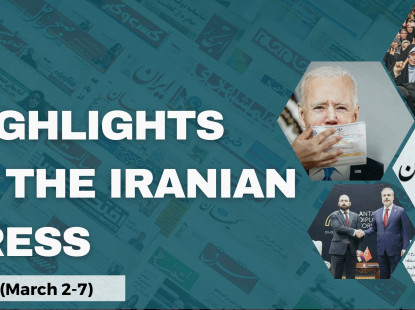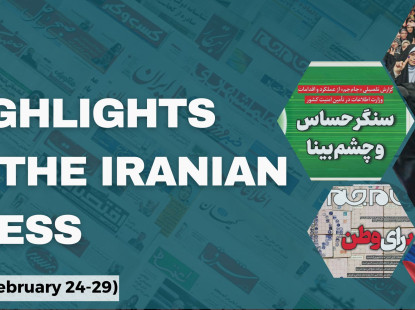The Perspectives of the Think Tanks in Iran Towards Taliban
The Taliban’s control over Afghanistan has created reflections on the think tanks in Iran as well as politics, media, and society. For a couple of years, the Tehran administration has cooperated with the Taliban against the USA and characterized the Taliban’s control over the country as a victory against the USA. In line with the Tehran administration’s approach, the press that is known by their closeness to the establishment and broadcast in the conservative line started to report news concerning the Taliban that it is not like what it used to be, it has changed, and it does not represent a threat for Iran. While the conservative media has not brought the struggles of the “resistants” in Panjshir against the Taliban to the agenda, reformists have claimed that the Iranian government has to represent a negative attitude towards the Taliban. Approximately 500 political and civil activists, including reformist politicians and artists, wrote a letter of support for the “resistants” who fight against the Taliban. The articles that were published by the think tanks, on the other hand, offered several suggestions and warnings for the government concerning the future of the Taliban and Afghanistan. In this scope, it is possible to classify the articles and analysis that were published by the prominent think tanks about the Taliban into three categories: Iran’s Taliban policy and the geopolitical significance of the Afghanistan, Taliban’s purpose of revival of the “Islamic caliphate” and call for support for the struggle against Taliban.
Iran’s Taliban Policy and the Geopolitical Significance of Afghanistan
The relationship between Iran and the Taliban has witnessed several ups and downs since the arrival of the organization. The bilateral relations had followed a negative path after the Taliban’s control over northern Afghanistan in 1998 and the assassination of the workers in the Iranian Embassy in Mazar-i Sharif. In fact, Iran located military power on the Afghanistan border by considering a military operation against the Taliban. Following this incident, Iran defined the Taliban as an enemy and “terrorist organization” against Iran’s national and ideological interests and supported the anti-Taliban front most of the time. However, the changing conjecture after the US invasion of Afghanistan in 2001 forced Iran to cooperate with the Taliban. While the withdrawal of the USA from the country after 20 years and the Taliban’s control over Afghanistan have been causing Iran to follow a surefooted policy, the articles that were published by the think tanks predict that a government led by the Taliban will be a threat for Iran’s national interest in the midterm and in the long run.
According to Mohammad Soltanpour’s article titled “Islamic Republic of Iran’s Foreign Policy towards Afghanistan, Realism and Idealism” that was published in the International Peace Studies Center, Iran that has a long border with Pakistan and Afghanistan is the most vulnerable state for the Taliban’s future actions among the countries who wanted the withdrawal of the USA from the region. In his article, Soltanpour expressed his concern towards the influence of Turkey and the countries that are close to Turkey over Afghanistan as follows: “When Turkey, Pakistan, Qatar axis that has positioned against the Syrian government, Hezbollah, and Iran in Syria for ten years is considered through its influence over Afghanistan, the ability of this axis to carry a conflict similar to Syria to the eastern borders of Iran should be paid attention.” This statement also represents a warning for the Iranian government.
In Behnaz Asadikia’s article titled “The Developments in Afghanistan and the Geopolitical Map of the Region” in the International Peace Studies Center, it is stated that after the withdrawal from Afghanistan, the attempts of the regional powers to fulfill the gap for protection of the regional stability and increasing their area of influence have been intensified. Moreover, the article emphasizes that in the atmosphere of uncertainty that has risen through this gap in Afghanistan, the competition for influence and new “geopolitical conflicts” will arise. According to the article, all of the countries in the region have a specific interest that affects their participation in Afghanistan’s future and the power play in the region has been redefined. Iran should be prepared for the potential threats that are caused by Afghanistan as a state which has an approximately 900 km border with this country and should not lose its area of influence. Furthermore, in this context, it is stated that “due to the realities of geographic determinism including the existence of border and security problems, hidropolitic issues between the two states, immigration and refugee problems, and the impacts of these on Iran and Afghanistan, the geopolitical pressure on Iran from its eastern border will intensify.”
Taliban Aims the Revival of “Islamic Caliphate”
Iran has seen the Taliban as an enemy against its ideological interests for many years. Taliban, on the other hand, has acknowledged Iran as an enemy due to Iran’s representation of the Shiites. Despite the relative rapprochement between Iran and the Taliban, the two parties will continue to see each other as a potential threat because of their ideological tendencies. Soltanpour indicated that the differentiation between the ideological tendencies of Iran and the Taliban will trigger future problems. According to him, Shiite Iran has been always perceived as a number one enemy in the region by the extremist Sunni-Salafi movements. It has the potential to turn into a significant trump card against Iran in the case of a change in the regional balance of power and a conflict of interest between some countries and Iran.
Islam Zolghadrpour’s article titled “From DAESH’s Black Flag to Taliban’s White Flag” that was published by the Center for Strategic Studies suggests that instead of an ideological optimism or pessimism towards Taliban, “there is a necessity to be careful against the authoritarian tendency of the organization and a necessity to be concerned because of its global purposes and intentions.” Zolghadrpour states that one of the most apparent components of the concerns towards the Taliban administration is the dictation of the organization’s flag as the “national flag” instead of “Afghanistan’s national flag”. This is interpreted as a sign that the organization will not settle for Afghanistan and will covet all the Islamic states as DAESH did. The article underlines that the Taliban’s monotype white flag which includes the statement of tawhid, may liken to DAESH’s monotype black flag and it should not be forgotten that the Taliban shares DAESH’s expansionism purpose. The reasons for the Taliban to choose this flag are listed as follows:
1. The statement of tawhid that is on the Taliban’s white flag is a symbol that is believed to represent Islamic unity. Placing this statement in the flag which expresses the oneness of Allah and the existence of Muslims together, indicates the unifying role of the future “emirate” for Muslims all over the world.
2. The fact that the Taliban’s flag does not include any sign about Afghanistan’s national or historic identity means that the organization has an intention and purpose which goes beyond the Afghanistan territory.
3. The Taliban’s flag, which is significantly similar to the flag of DAESH, is an indicator that shows the aim of globalization of Islam and the establishment of an Islamic Empire that is hidden in the minds and intentions of the organization.
According to the author, “Taliban’s purpose should be understood thanks to the symbol in its flag. This purpose is the revival of an Islamic Empire or Islamic caliphate which includes the Islamic territory from Northern Africa to India.” The author warns Iran and the regional states to be awake for the Taliban and the revival of the organizations like DAESH which may take the Taliban’s rise as an example.
Call for Support for the Struggle Against Taliban
While the reformists in Iran are calling for support for the anti-Taliban groups, the conservatives who hold the government ignore these calls through the “wait and see” policy. The article of the Soltanpour includes the statements that “If the Islamic Republic does not use the minimum means to defend the interests of the Shiites and the Persian-speaking population in Afghanistan, it will damage the main claim of the establishment in its struggle with the USA along with the principal doctrine of the Revolution. In addition to the loss of objective interests in the eastern border, it will cause a loss for Iran in terms of its moral and cultural influence in the region.” According to Soltanpour, the Persian-speaking fields and the resistance movements in the Shiite-populated areas should be supported in the region to decrease the potential risk of Taliban. The support for the resistants is referred through its potential to prevent potential threats by decreasing the future risks, and it is argued to has an ability to turn into a trump card against the Salafi extremism and the influence of Turkey and Pakistan on the eastern border of the Islamic Republic.
In his interview with the Institute for Iran-Eurasia Studies, Dr. Jafar Mahdavi stated that the resistance against the Taliban in Panjshir will not spread to the other cities of the country, and this resistance will not be supported by the people in Panjshir and the Afghan people. He also underlined that the resistance in Panjshir and the region should not be considered as a serious development. According to Mahdavi, the majority of countries will not want to invest in an area with no future and the Panjshir resistance is a movement without a future.
In conclusion, the approach towards the Taliban is becoming a chronic problem and may transform into a factor that triggers social polarization. The dominant ideology in Iran approaches the developments in the world through realpolitik and geopolitics instead of an ideological attitude. This approach paved the way for a rapprochement with the Taliban because of its tensions with the USA, even though the Taliban is completely incompatible in terms of ideology. Nevertheless, this rapprochement is not valid for some opponents who approach the developments based on human rights instead of a geopolitical approach and for some Iranians who have concerns about the potential of the radical Sunni organization’s preparation for the world caliphate. These segments of society continue to approach the Taliban with caution despite the tendency of the official circles to acknowledge the “changing image of Taliban”. The opponents defend to support the anti-Taliban Shiites and Persian-speaking population in Afghanistan by leaving the sectarian differences behind. Taliban’s policies towards Tajiks and Shiites in Afghanistan seemingly have the ability to accelerate the debates between the conservatives and reformists in Iran.
- Tags:
- Taliban
- Afghanistan
- Iran
- Think Tanks











